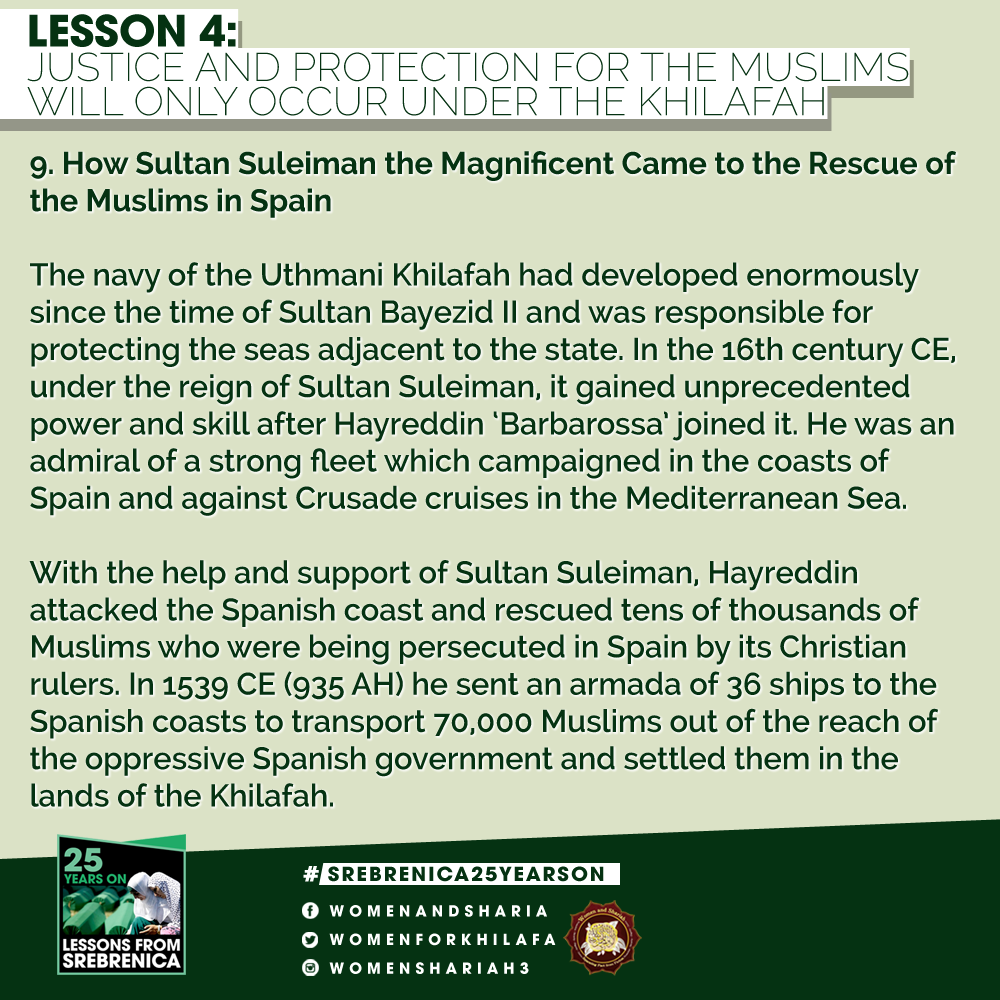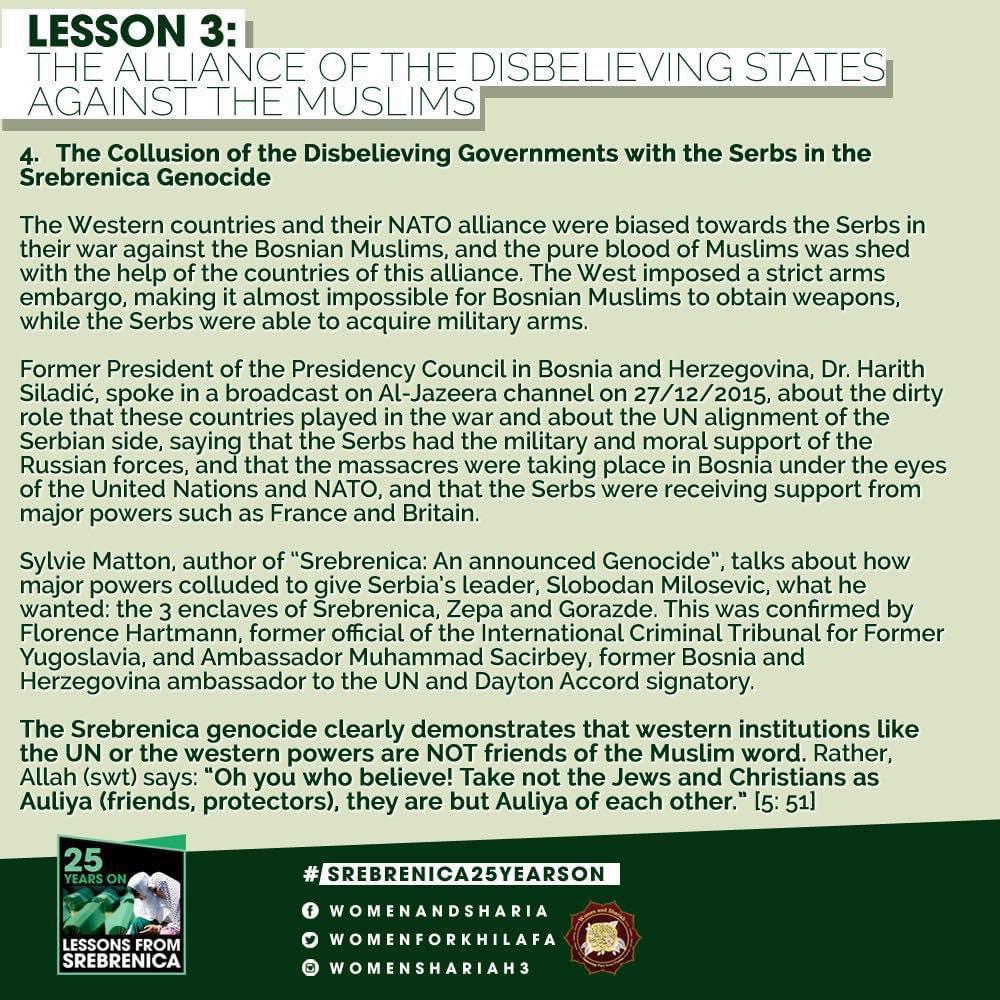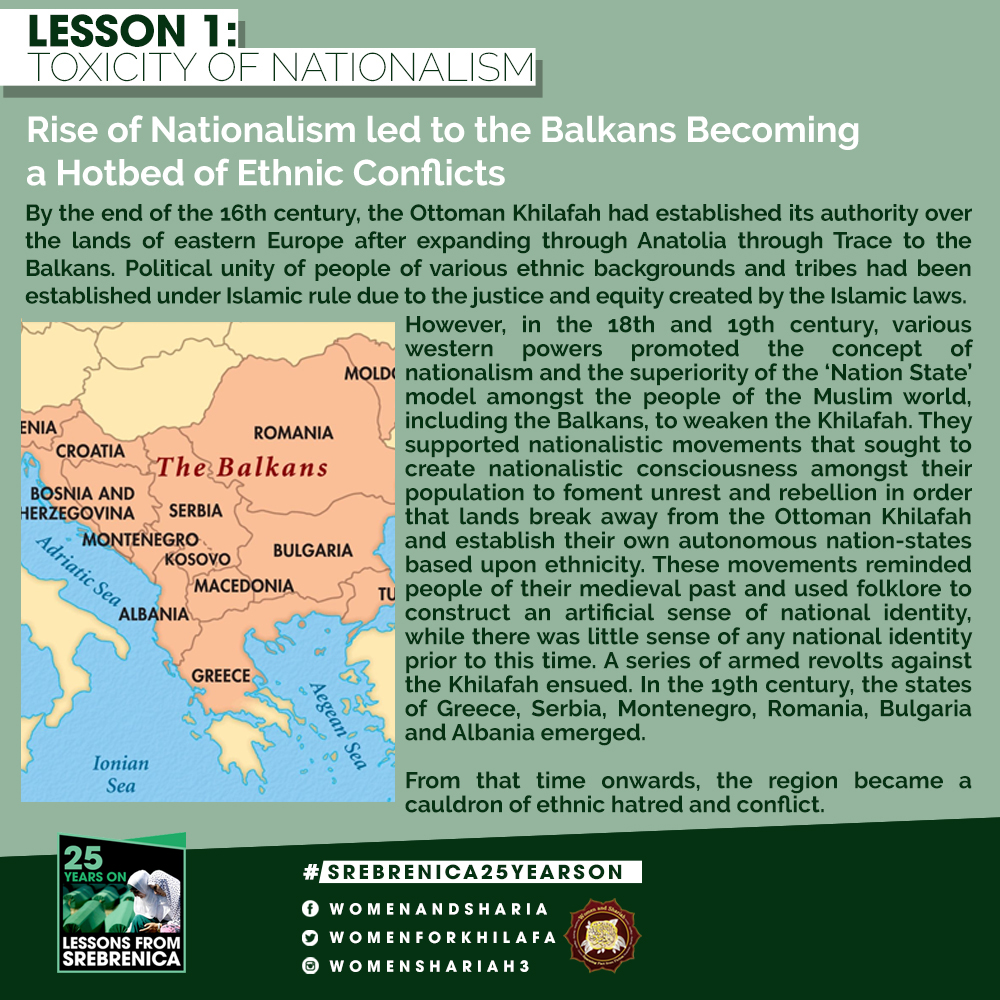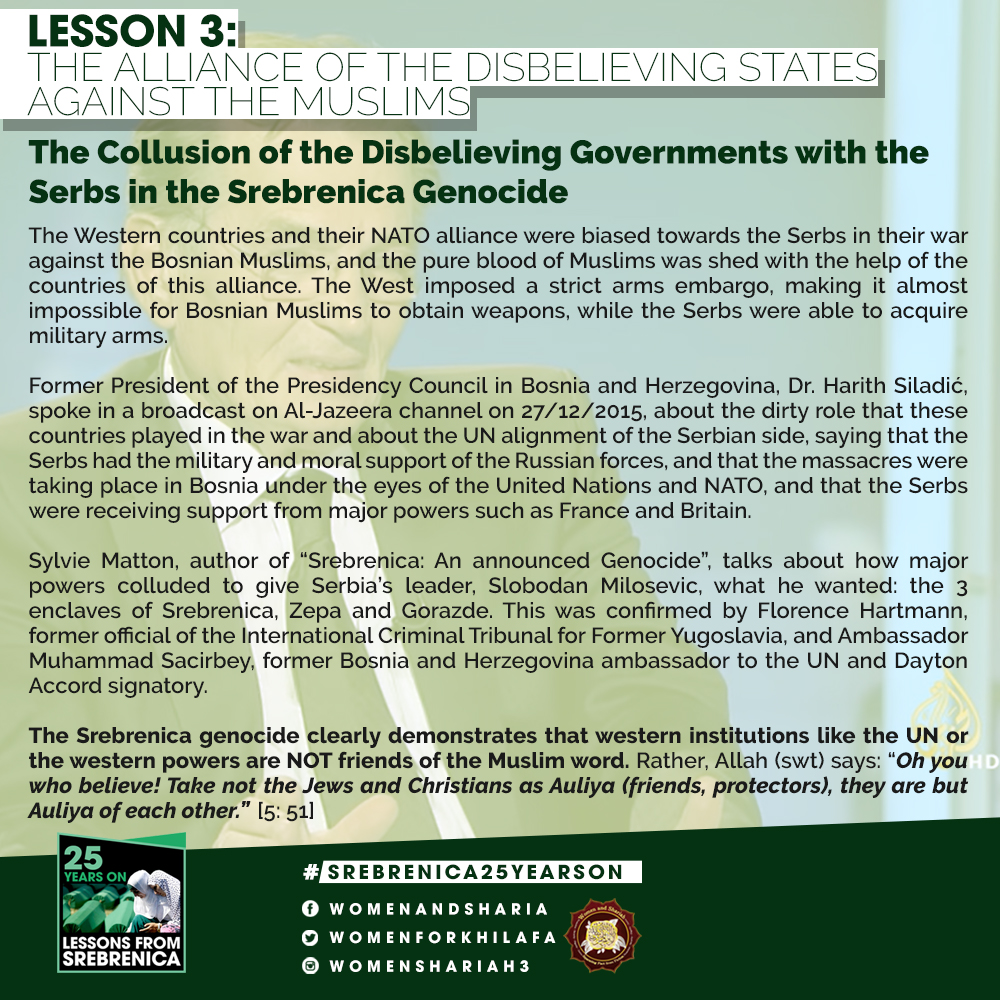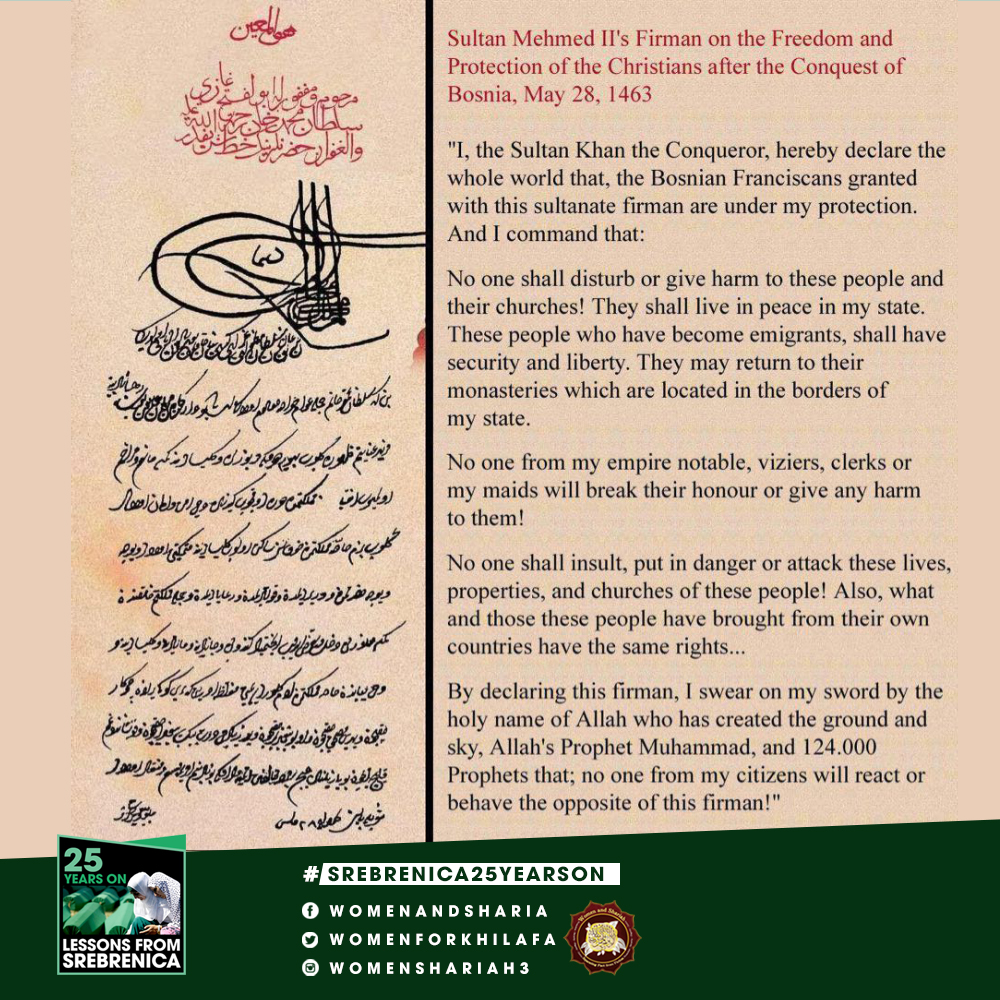بسم الله الرحمن الرحيم

Introduction for 25th Anniversary of Srebrenica Campaign:
“2 5 Y e a r s o n : L e s s o n s f r o m
S r e b r e n i c a”
WOMEN'S SECTION CENTRAL MEDIA OFFICE OF HIZB UT TAHRIR
On the 11th July, 1995, Serb forces invaded the Muslim enclave of Srebrenica in Bosnia in which tens of thousands of Muslims had taken refuge from the Serbian army’s offensive in north-eastern Bosnia. The town had been designated as a “safe area” by the United Nations (UN) and declared as being under UN protection. In the days following the capture of Srebrenica, 8000 Muslim men and boys were executed in cold blood by the Serbs. It was described as the worst atrocity on European soil since World War 2. Alongside the massacre, 25 to 30,000 Muslim women, children and elderly were expelled from the town as part of the Serb’s brutal campaign of ethnic cleansing of Muslims from lands bordering the Republic of Serbia. The Muslims of Srebrenica were promised protection by the UN but that protection never came. They were promised that western governments would halt the Serb onslaught through NATO but that help never materialised.
The Srebrenica genocide was only one of the litany of atrocities committed by Serb forces against the Bosnian Muslims in the Bosnian war while the governments of the world – Muslim and non-Muslim - watched on.
In the years following the Srebrenica massacre, the world promised, “Never Again” and that lessons would be learnt from this dark stain in modern history. However, today we see the slaughter and crimes of the Bosnian war and the Srebrenica genocide replicated against Muslims in lands across the world – including in Syria, Myanmar, Kashmir, Palestine, Yemen, East Turkestan and India while the world again watches on. The Prophet (saw) said:
«لاَ يُلْدَغُ الْمُؤْمِنُ مِنْ جُحْرٍ وَاحِدٍ مَرَّتَيْنِ»
“The believer does not allow himself to be stung twice from the same hole.” So, what are the true lessons that should be learnt from this human tragedy? How can the remembrance of the brutal events of the past help us to reshape our future as Muslims to achieve security and justice? How can we break the legacy of genocides which afflict our Ummah…so that history does not continue to repeat itself?
This campaign launched by the Women’s section in the Central Media Office of Hizb ut Tahrir hopes to address these issues.
Dr. Nazreen Nawaz
Director of the Women's Section of the Central Media Office of Hizb ut Tahrir
Monday, 15 Dhu al-Qi'dah 1441 AH corresponding 6 July 2020 CE

Follow Campaign in Other Languages
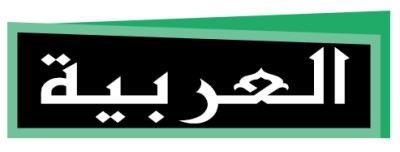




Press Release from The Women’s Section in the Central Media Office of Hizb ut Tahrir
Launch a Campaign on the 25th Anniversary of the Srebrenica Genocide:
| #Srebrenica25YearsOn | |||
| #سربرنيتشا_جرح_لم_يندمل | |
||
| #Srebrenitsa25Yıl | |


-
 Click to open image!
Click to open image!
Click to open image!
Click to open image!
-
 Click to open image!
Click to open image!
Click to open image!
Click to open image!
-
 Click to open image!
Click to open image!
Click to open image!
Click to open image!
-
 Click to open image!
Click to open image!
Click to open image!
Click to open image!
-
 Click to open image!
Click to open image!
Click to open image!
Click to open image!
-
 Click to open image!
Click to open image!
Click to open image!
Click to open image!
-
 Click to open image!
Click to open image!
Click to open image!
Click to open image!
-
 Click to open image!
Click to open image!
Click to open image!
Click to open image!
-
 Click to open image!
Click to open image!
Click to open image!
Click to open image!
-
 Click to open image!
Click to open image!
Click to open image!
Click to open image!
-
 Click to open image!
Click to open image!
Click to open image!
Click to open image!
https://hizbut-tahrir.info/en/index.php/hizbuttahrir/19753.html#sigProId11970fa75b
-
 Click to open image!
Click to open image!
Click to open image!
Click to open image!
-
 Click to open image!
Click to open image!
Click to open image!
Click to open image!
-
 Click to open image!
Click to open image!
Click to open image!
Click to open image!
-
 Click to open image!
Click to open image!
Click to open image!
Click to open image!
-
 Click to open image!
Click to open image!
Click to open image!
Click to open image!
-
 Click to open image!
Click to open image!
Click to open image!
Click to open image!
-
 Click to open image!
Click to open image!
Click to open image!
Click to open image!
-
 Click to open image!
Click to open image!
Click to open image!
Click to open image!
-
 Click to open image!
Click to open image!
Click to open image!
Click to open image!
https://hizbut-tahrir.info/en/index.php/hizbuttahrir/19753.html#sigProIdec05e189bf
-
 Click to open image!
Click to open image!
Click to open image!
Click to open image!
-
 Click to open image!
Click to open image!
Click to open image!
Click to open image!
-
 Click to open image!
Click to open image!
Click to open image!
Click to open image!
-
 Click to open image!
Click to open image!
Click to open image!
Click to open image!
-
 Click to open image!
Click to open image!
Click to open image!
Click to open image!
-
 Click to open image!
Click to open image!
Click to open image!
Click to open image!
-
 Click to open image!
Click to open image!
Click to open image!
Click to open image!
-
 Click to open image!
Click to open image!
Click to open image!
Click to open image!
-
 Click to open image!
Click to open image!
Click to open image!
Click to open image!
-
 Click to open image!
Click to open image!
Click to open image!
Click to open image!
https://hizbut-tahrir.info/en/index.php/hizbuttahrir/19753.html#sigProIdaf3a504f34
-
 Click to open image!
Click to open image!
Click to open image!
Click to open image!
-
 Click to open image!
Click to open image!
Click to open image!
Click to open image!
-
 Click to open image!
Click to open image!
Click to open image!
Click to open image!
-
 Click to open image!
Click to open image!
Click to open image!
Click to open image!
-
 Click to open image!
Click to open image!
Click to open image!
Click to open image!
-
 Click to open image!
Click to open image!
Click to open image!
Click to open image!
-
 Click to open image!
Click to open image!
Click to open image!
Click to open image!
-
 Click to open image!
Click to open image!
Click to open image!
Click to open image!
-
 Click to open image!
Click to open image!
Click to open image!
Click to open image!
-
 Click to open image!
Click to open image!
Click to open image!
Click to open image!
-
 Click to open image!
Click to open image!
Click to open image!
Click to open image!
https://hizbut-tahrir.info/en/index.php/hizbuttahrir/19753.html#sigProId3533d9439a
https://hizbut-tahrir.info/en/index.php/hizbuttahrir/19753.html#sigProId00b9623a45
-
 Click to open image!
Click to open image!
Click to open image!
Click to open image!
-
 Click to open image!
Click to open image!
Click to open image!
Click to open image!
-
 Click to open image!
Click to open image!
Click to open image!
Click to open image!
-
 Click to open image!
Click to open image!
Click to open image!
Click to open image!
-
 Click to open image!
Click to open image!
Click to open image!
Click to open image!
-
 Click to open image!
Click to open image!
Click to open image!
Click to open image!
-
 Click to open image!
Click to open image!
Click to open image!
Click to open image!
-
 Click to open image!
Click to open image!
Click to open image!
Click to open image!
-
 Click to open image!
Click to open image!
Click to open image!
Click to open image!
https://hizbut-tahrir.info/en/index.php/hizbuttahrir/19753.html#sigProId2dd860ce69

https://hizbut-tahrir.info/en/index.php/hizbuttahrir/19753.html#sigProId99a878320c


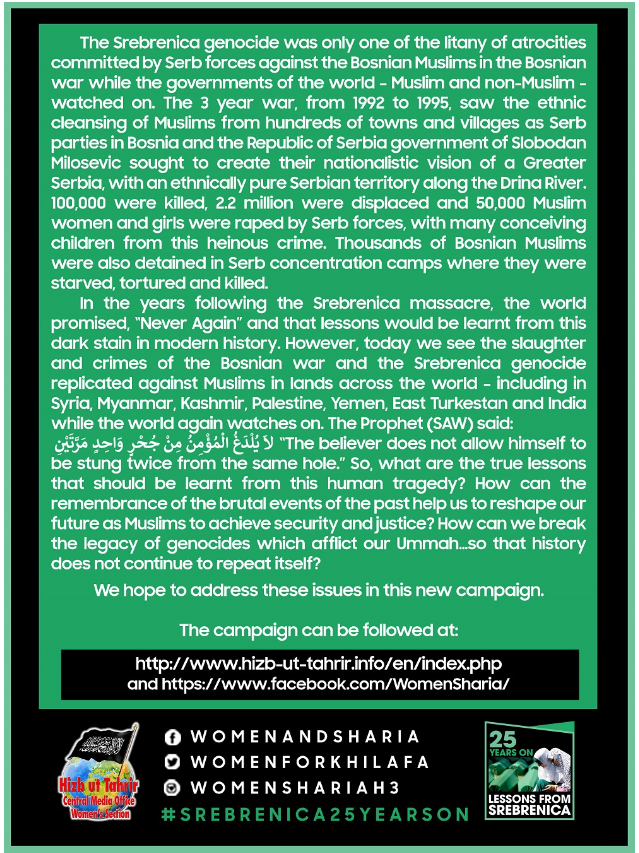


On the 11th July, 1995, Serb forces invaded the Muslim enclave of Srebrenica in Bosnia in which tens of thousands of Muslims had taken refuge from the Serbian army’s offensive in north-eastern Bosnia. The town had been designated as a “safe area” by the United Nations (UN) and declared as being under UN protection. In the days following the capture of Srebrenica, 8000 Muslim men and boys were executed in cold blood by the Serbs. It was described as the worst atrocity on European soil since World War 2. On the 25th anniversary of the massacre, this panel discussion seeks to address the lessons that should be learnt from this human tragedy so that the history of genocides and slaughter which afflicts the Muslim Ummah can be brought to an end and a future of security and justice established.









